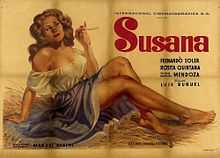Susana (film)
| susana grillo demonio y carne | |
|---|---|
 Theatrical poster | |
| Directed by | Luis Buñuel |
| Produced by |
Sergio Kogan Manuel Reachi |
| Written by |
Luis Buñuel Jaime Salvador Rodolfo Usigli based on the novel by Manuel Reachi |
| Starring |
Rosita Quintana Fernando Soler |
| Music by | Raúl Lavista |
| Cinematography | José Ortiz Ramos |
| Edited by | Jorge Bustos |
Release dates | 1951 |
Running time | 82 minutes |
| Country | Mexico |
| Language | Spanish |
Susana (Susana, demonio, y carne or The Devil and the Flesh) is a 1951 film directed by Luis Buñuel. It is the story of a girl of questionable mental stability who escapes from incarceration and ends up at a plantation where she disrupts a working family's daily routines and chemistry.
Plot
Susana is full of the unique touches of Buñuel's surrealism. The heroine, Susana (Rosita Quintana), is a beautiful inmate at a women's reformatory who escapes in the middle of a rainy night. When first seen, Susana's being thrown into a solitary cell for misbehaving and the correction officer says Imagine, she's been here two years and is worse than ever!.
In her cell she asks God's help, facing a shadow of the cross formed by the window bars from where a spider crawls away. The window breaks open and she escapes. She ends up at a ranch. Soon the whole household is involved in possessing her and fighting over her. Jesus, the young ranch helper; Alberto, the family's son and heir; and Guadalupe, Alberto's father, 'a God-fearing man and the faithful husband of the beautiful, patient Dona Carmen'.
Analysis
Though the movie means to be steamy, Buñuel is apparently more amused than shocked by Susana's brazen ambition and the no-nonsense way she goes about her conquests. Toward the end, when the traffic in and out of Susana's bedroom is fairly heavy, the movie has the manner of a grandly operatic farce. Miss Quintana is suitably outrageous as Susana, a kind of rough sketch of the character who would later appear in the person of Catherine Deneuve in Buñuel's 1970 classic, Tristana. That film is also recalled because of the appearance of Fernando Soler, who plays the susceptible Don Guadalupe and who looks remarkably like Fernando Rey, the star of Buñuel's last, great films.[1]
Gilles Deleuze in his work Cinema 1: The Movement Image talks about the impulse-image in Susana "that achieves the complete exhaustion of a milieu: mother, servant, son and father. The impulse must be exhaustive. It is not even sufficient to say that the impulse contents itself with what a milieu gives it or leaves to it. This contentment is not resignation, but a great joy in which the impulse rediscovers its power of choice, since it is, at the deepest level, the desire to change milieu, to seek a new milieu to explore, to dislocate, enjoying all the more what this milieu offers, however low, repulsive or disgusting it may be. The joys of the impulse cannot be measured against the affect, that is, against the intrinsic qualities of the possible object."
References
- ↑ CANBY, VINCENT (November 8, 1983). "FILM: BUNUEL'S 'SUSANA,' MADE IN '51". New York Times.
External links
- Susana at the Internet Movie Database